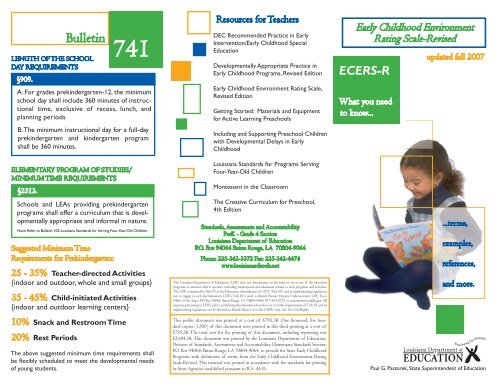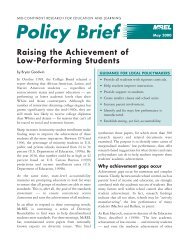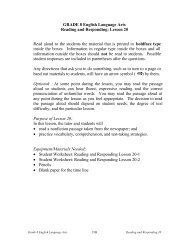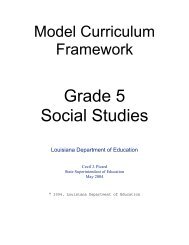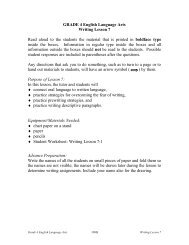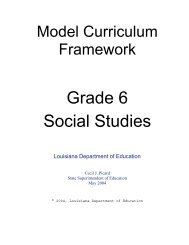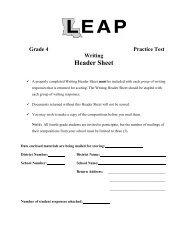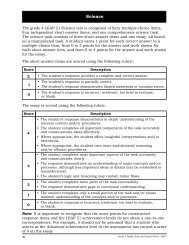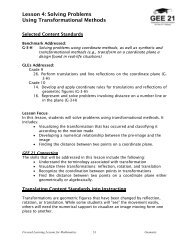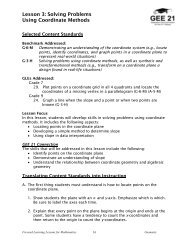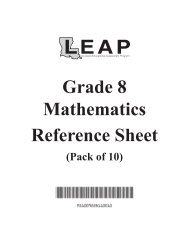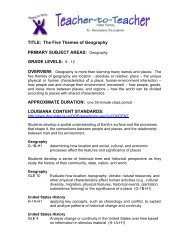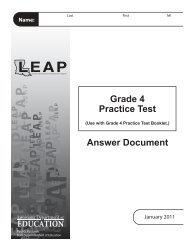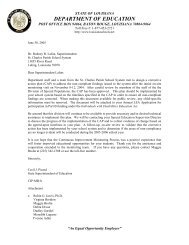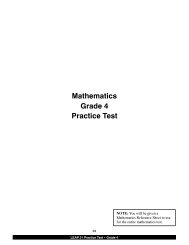Early Childhood Environment Rating Scale-Revised - Louisiana ...
Early Childhood Environment Rating Scale-Revised - Louisiana ...
Early Childhood Environment Rating Scale-Revised - Louisiana ...
- No tags were found...
You also want an ePaper? Increase the reach of your titles
YUMPU automatically turns print PDFs into web optimized ePapers that Google loves.
LENGTH OF THE SCHOOLDAY REQUIREMENTS§909.ELEMENTARY PROGRAM OF STUDIES/MINIMUM TIME REQUIREMENTSSuggested Minimum TimeRequirements for Prekindergarten:25 - 35% Teacher-directed Activities{indoor and outdoor, whole and small groups}35 - 45% Child-initiated Activities{indoor and outdoor learning centers}10% Snack and Restroom Time20% Rest PeriodsBulletin741A. For grades prekindergarten-12, the minimumschool day shall include 360 minutes of instructionaltime, exclusive of recess, lunch, andplanning periodsB. The minimum instructional day for a full-dayprekindergarten and kindergarten programshall be 360 minutes.§2313.Schools and LEAs providing prekindergartenprograms shall offer a curriculum that is developmentallyappropriate and informal in nature.Note: Refer to Bulletin 105-<strong>Louisiana</strong> Standards for Serving Four-Year-Old Children.The above suggested minimum time requirements shallbe flexibly scheduled to meet the developmental needsof young students.Resources for TeachersDEC Recommended Practice in <strong>Early</strong>Intervention/<strong>Early</strong> <strong>Childhood</strong> SpecialEducationDevelopmentally Appropriate Practice in<strong>Early</strong> <strong>Childhood</strong> Programs, <strong>Revised</strong> Edition<strong>Early</strong> <strong>Childhood</strong> <strong>Environment</strong> <strong>Rating</strong> <strong>Scale</strong>,<strong>Revised</strong> EditionGetting Started: Materials and Equipmentfor Active Learning PreschoolsIncluding and Supporting Preschool Childrenwith Developmental Delays in <strong>Early</strong><strong>Childhood</strong><strong>Louisiana</strong> Standards for Programs ServingFour-Year-Old ChildrenMontessori in the ClassroomThe Creative Curriculum for Preschool,4th EditionStandards, Assessments and AccountabilityPreK - Grade 4 Section<strong>Louisiana</strong> Department of EducationP.O. Box 94064 Baton Rouge, LA 70804-9064Phone: 225-342-3372 Fax: 225-342-4474www.louisianaschools.netThe <strong>Louisiana</strong> Department of Education (LDE) does not discriminate on the basis of sex in any of the educationprograms or activities that it operates, including employment and admission related to such programs and activities.The LDE is required by Title IX of the Education Amendments of 1972 (Title IX) and its implementing regulationsnot to engage in such discrimination. LDE’s Title IX Coord. is Patrick Weaver, Deputy Undersecretary, LDE, Exec.Office of the Supt.; PO Box 94064, Baton Rouge, LA 70804-9064; 877-453-2721 or customerservice@la.gov. Allinquiries pertaining to LDE’s policy prohibiting discrimination based on sex or to the requirements of Title IX and itsimplementing regulations can be directed to Patrick Weaver or to the USDE, Asst. Sec. for Civil Rights.This public document was printed at a cost of $795.38. One thousand, five hundredcopies (1,500) of this document were printed in this third printing at a cost of$795.38. The total cost for the printing of this document, including reprinting was$2,694.38. This document was printed by the <strong>Louisiana</strong> Department of Education,Division of Standards, Assessments and Accountability, Elementary Standards Section;P.O. Box 94064; Baton Rouge, LA 70804-9064, to provide the State <strong>Early</strong> <strong>Childhood</strong>Programs with definitions of terms from the <strong>Early</strong> <strong>Childhood</strong> <strong>Environment</strong> <strong>Rating</strong><strong>Scale</strong>-<strong>Revised</strong>. This material was printed in accordance with the standards for printingby State Agencies established pursuant to R.S. 43:31.<strong>Early</strong> <strong>Childhood</strong> <strong>Environment</strong><strong>Rating</strong> <strong>Scale</strong>-<strong>Revised</strong>ECERS-RWhat you needto know...updated fall 2007...terms,examples,references,and more.<strong>Louisiana</strong> Department ofEDUCATIONReaching For ResultsPaul G. Pastorek, State Superintendent of Education
ECERS-RThe <strong>Early</strong> <strong>Childhood</strong> <strong>Environment</strong><strong>Rating</strong> <strong>Scale</strong>-<strong>Revised</strong>An early childhood evaluation instrument used todetermine program quality. The ECERS-R is designedto be used in ALL programs that serve children from3-5 years of age. The <strong>Louisiana</strong> State Departmentof Education uses this instrument to ensure that highquality early childhood programs are being providedacross the state. Additional notes for <strong>Louisiana</strong> onECERS-R are available on the Department’s websiteat www.louisianaschools.net.Definitions of Terms Used in the ECERS-R <strong>Scale</strong>ACCESSIBLEChildren can reach and use the materials, furnishings,equipment, etc. in the classroom. Access can be limitedto a certain number of children in an area or limited tocertain times of the day.NOTEAccessible also relates to children and adults with disabilitieswho are currently a part of the program.FREE PLAYChildren are able to selecttheir own centers,activities, materials andcompanions, and are ableto manage their own playindependently. (RELATES TOCHILD-INITIATED ACTIVITIES INBULLETIN 741). There is adultinteraction in responseto the children’s developmentalneeds as well as inintroducing and enforcingconcepts.NOTEWhen children areassigned to centersby staff or the staffselects the activities,materials, etc. for individualchildren, this isNOT considered freeplay or child-initiatedactivity. See page 64in ECERS-R. See page367 in All About theECERS-R.GROSS MOTOR PLAYSpace is adequate both outdoors and/or indoors forthe number of children in the group. Space is easilyaccessible to all children in the group, and the equipment(portable and stationary) is accessible to thechildren for at least 45 min. a day.INDIVIDULAIZED WORKEach child is allowed to select the subject and/or mediaand create in his/her own way. The individual productslook quite different from one another.NOTEProjects where children follow a teacher’s exampleor pattern and little creativity is allowed are NOTconsidered individualized work.See pages 17, 41 in ECERS-R.See pages 51-53 & 201-204 in All About the ECERS-R.INTEREST CENTERAn area in the classroom used during free play/childinitiatedactivities. In each area, the materials areorganized by type and are stored so that they areaccessible to the children, the shelves have picture/word labels, and the area is appropriately furnished.Interest areas can also be established outdoors.EXAMPLEArt, blocks, reading, sand/water, nature/science, andmanipulatives/fine motor, outdoor/gross motor, etc.See pages 15, 39-57 in ECERS-R.SPACE FOR PRIVACYThe intent of this space is to give children relief fromthe pressures of group life. It is a place where one ortwo children can play protected from intrusion byother children, but can easily be supervised by staff.EXAMPLESmall loft area, activity center limited to one or twochildren, a see-through tent with cushions inside, asmall outdoor playhouse, etc.See page 16 in ECERS-R.See page 35 in All About the ECERS-R.SUBSTANTIAL PORTION OF THE DAYFree play/child-initiated activities are available to thechildren at least one-third of the instructional day.EXAMPLE6 hour instructional day = 2 hours6.5 hour instructional day = 2 hours 10 min.7 hour instructional day = 2 hours 20 min.See page 7 in ECERS-R.See pages xviii & xix in All About the ECERS-R.


